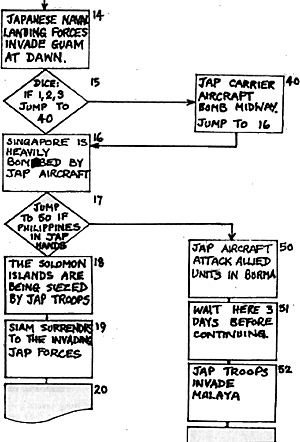 Being a solo wargamer I have often given some thought to designing a programme to provide an
element of surprise in the strategic plans of the "enemy". Given sufficient time it is not too
difficult to draw up a number of separate plans that the enemy might adopt; the actual plan used can be chosen by dice or other means, and once these plans are made they can be used for any number of games when one is without an opponent.
Being a solo wargamer I have often given some thought to designing a programme to provide an
element of surprise in the strategic plans of the "enemy". Given sufficient time it is not too
difficult to draw up a number of separate plans that the enemy might adopt; the actual plan used can be chosen by dice or other means, and once these plans are made they can be used for any number of games when one is without an opponent.
Computers work to a series of instructions and by virtue of their sheer speed are usually more economical than other methods. In making strategic decisions this speed is not normally required, but like the computer, my programmes comprise a series of instructions which take into account the varying situations that arise. At present I use this system for Japanese World War II strategy. With so many islands and isolated areas featuring in the war in the Far East, the position is ideal for this type of programme; the Japanese in the initial stages of the war have complete freedom of movement and so complete and utter surprise is achieved.
The first essential item is the construction of a flow chart which sets out the course of the whole strategic programme. It is advisable to use large sheets of paper for this: it is quite easy to lose one or two ends if a number of small sheets are used. The chart can be compiled as in the example shown, using a diamond shape when a decision is required and a simple square for normal instructions. The course of the programme moves according to the decisions which can be based on several factors, from the throw of a dice for sheer chance, whether or not an area has capitulated to the enemy, where the greatest threat is posed, forces available, to even the time of year - a winter or monsoon approaching may not auger well for the start of a great offensive. All these possibilities and more can be considered when planning the strategy (or tactics), and this can sometimes be almost as rewarding as the game itself. The depth and scope of the instructions of course depeud on the individual.
Once the flow chart is complete the instructions are then typed out on cards which are kept in order on a card index box. Instructions which are to occur simultaneously can be written on the same card, or if one so desires each card has only one instruction. The cards are numbered in the top right-hand corner and must be drawn in sequence unless the instruction indicates a jump to a card elsewhere. After being drawn cards are placed at the rear of the box. A new card can be drawn at the start of each day of a campaign, or once a week, fortnight, month, or as required. Chance conditions are provided for, and yet a logical sequence of events can be maintained so that surprise and credibility can be achieved.
Programmes can be as complex or as simple as required: one can use modifiers or indicators for several purposes, for example each area can be allotted a code number; next to the code number is a zero when that area is inviolate, and when the enemy in- vade it a figure 1 is inserted by the code number; once the area has fall ' en to the enemy a 2 could be inserted. Decisions can then be based on the style of this figure.
Initially I would think it advisable for anyone attempting this method of formulating enemy strategy to compile a few simple programmes with varying plans and draw or dice for the one to be used. However, it is quite feasible to write one programme and include so many variables that several possible courses could be taken. It is unwise to attempt writing out the cards without first drawing up the flow chart. My example has been a strategical situation but this computerised system can also be adapted for tactics.
Of necessity this article is but a short introduction to the system -- it would take a book to cover it in detail, and even then one would be limited. However, in hope this may stimulate ideas for planned solo wargaming and provide a new dimension to this fascinating hobby.
Back to Table of Contents -- Wargamer's Newsletter # 101
To Wargamer's Newsletter List of Issues
To MagWeb Master Magazine List
© Copyright 1970 by Donald Featherstone.
This article appears in MagWeb.com (Magazine Web) on the Internet World Wide Web.
Other articles from military history and related magazines are available at http://www.magweb.com